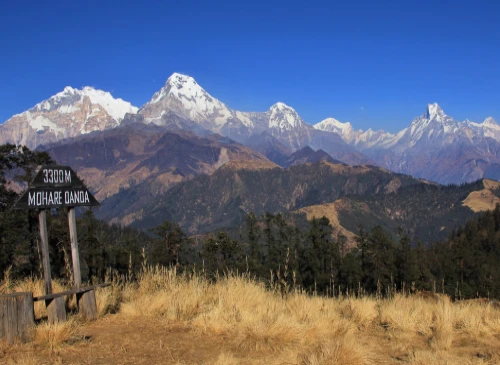The Pokhara Dhampus Trek is a short trekking route that occupies 4 days, giving you a wonderful chance to experience nature and Nepalese culture. The trek begins at Pokhara, the city of beautiful lakes and panoramic views of the Himalayan range, Annapurna in particular, and gets into the zone, passing through forests, fields, and a few nice ethnic villages. Pokhara to Dhampus is probably about 20 kilometers, so this trek is short and would not take much time even for inexperienced hikers and walkers. Engaging in this journey will lead you through outstanding scenery that depicts authentic Nepalese village life.
The most entertaining and exciting part of the Dhampus village trek is reaching the small, beautiful village of Dhampus at a height of 1750 m. It is the starting point for trekking to the Annapurna area and has a magnificent view of Annapurna and the Dhaulagiri Himal. The first light of the day illuminates the snow-crowned mountains during the trek also allows us to not only enjoy the scenic beauty of the Himalayas but also to walk through the real society of the Gurung people and their equally hospitable and culturally significant way of life.to walk through the real society of the Gurung people and their equally hospitable and culturally significant way of life.
During the entire length of the Pokhara Dhampus trekking, the trekkers can feel the calmness and peace behind this area. The path is easily navigable and relatively easy, making it an ideal choice for those who want to immerse themselves in the breathtaking scenery of the Himalayan mountains without the need to brave vast terrains or climb. Furthermore, because the trek is located near Pokhara, travelers have the opportunity to visit the culturally bustling city and explore sites like Phewa Lake or the World Peace Stupa before or after the trek. Together, the Pokhara Dhampus Trek can be a prestigious and valuable adventure trip because it has overall availability, natural beauty, and cultural heritage in a short time.
Dhampus Village Trek Route
Beginning the Dhampus trek, the route gently climbs through the dense forests of rhododendrons and oaks, through which you may sight some typical Nepalese animals and beautiful birds (166). The trail is moderate in difficulty and has relatively easy signals to guide the trekkers; hence, it should be considered a must-do for families and first-time trekkers. On the way, you will come across attractive places such as small villages and cheerful people, which will allow you to experience the essence of the region's cultural landmarks. The journey is an integral part of the experience, revealing more of Nepal's beauty and the people's cultural way of life with every passing day.
Finally, on arriving at Dhampus village, trekkers get to view the world-famous panorama of the Annapurna and Dhaulagiri ranges. Dhampus is a beautiful village in Nepal with an altitude of about 5700 feet. It is also famous for panoramic views of the Himalayas, including Mount Fishtail (Machhapuchare). It becomes the gateway to exploring the real natural beauty of the Himalayas as the villagers wake up to the first sunrise. There is the cultural aspect of the Dhampus village trek, where trekkers get a chance to interact with the Gurung community's local people and understand their way of life. The entire Pokhara Dhampus trekking tour is all the more special due to the natural and cultural blessings tucked in this area.
The Australian Base Camp
One of the most amazing treks in the Annapurna region, the Australian Base Camp offers lovely views and a rich cultural experience. One of the beginning routes of this trek departs from the city of Pokhara, which takes trekkers to the Australian Base Camp. The viewpoint is at an elevation of about 2300 m. Here, you are given the simply stunning terrain of the Annapurna and the Dhaulagiri Mountains. What better place to capture photographs and take a much-deserved break? The initial 8-kilometer trail covering the forest and the fields to approach the Australian Base Camp offers a rather soft exploration that makes the travelers conversant with the rustic geography of Nepal before immersing them deep in the region.
Beyond the Australian Base Camp, the trek leads to Dhampus, Nepal, one of the most beautiful villages with rich cultural practices. The trek from base camp to Dhampus is relatively downward through lovely villages and much more terrain. On the way to Dhampus, you will get to see the wonderful mass of the Himalayan ranges and the peaceful village of the Gurungs. The Dhampus Trek also offers a great chance to get close to the people of this region and get the warmest greeting and encouragement from the Nepali people because they are simple-hearted and friendly folks. The emptiness of this particular location in Nepal is also accessible during this trek. Hence, the interaction of the physical beauty of nature with culturally historic and traditional points of interest makes trekking from the Australian Base Camp to Dhampus a fulfilling and astounding experience.
What can one expect during the Pokhara Dhampus Trek?
Starting the Pokhara Dhampus Trek, an absolutely beautiful 4-day trek, one can expect a great view and a glimpse of Nepalese culture. As you depart from Pokhara, the Annapurna region's diverse terrain gradually reveals its beauty. The first day of the trek involves a gradual climb through the forests and terracing fields, which will give you the feel of Nepalese villages. The first days of acclimatization are quite picturesque; hikers may see various hills and valleys that prepare them for the views of the gems. On the way, you will be interacting with the indigenous Gurung people, who are warm-hearted and cultural.
The first part of the Pokhara Dhampus trekking is not so difficult; however, with the continuation of the trek, the trail offers more variety, like gentle climbs and sometimes steep climbs. In terms of physically walking into the woods, the trek through the elongated rhododendrons and oak woods is immensely captivating and invigorating. The incredible feature of the trek is the moment when travelers find themselves in the attractive village of Dhampus, perched at an altitude of about 1750 m. The view of the Annapurna and Dhaulagiri Range Mountains will be the first to welcome you. The village is quiet and calm, which provides an opportunity to rest adequately while also enjoying the scenic view of the exercise.
The final section of the Pokhara Dhampus trek will provide you with an opportunity to interact with the friendly people of the region and enjoy a tour of some traditional houses in the villages. Dhampus, Nepal, boasts beautiful natural beauties and friendly people; thus, it is the best place to start observing the sunrise over the Himalayas. The trek terminates at Poon Hill, from where it descends back to Pokhara to marvel at the places that the city has to offer before departing from there as well. For those who are interested in having a memorable adventure journey, the Pokhara Dhampus trek offers a beautiful mixture of everything all trekkers could ever ask for: from natural scenery that is very hard to capture through words up to cultural experiences, and also a moderate trekking grade for all those who want to have it easy on the higher altitudes.
The best season for the Pokhara Dhampus Trekking
The spring and autumn seasons are the best times to trek in Pokhara Dhampus. The best time for trekking is from late September to early December and from late March to early June because the weather is clear and the path has good stability. These are the months when the sky is clear and the climate is moderately cool, with temperatures averaging between 10 °C and 20 °C, or between 50 °F and 68 °F. This makes it appropriate for trekking. These seasons also offer great photo opportunities of the Annapurna and Dhaulagiri ranges, as the weather is clear and hence there is clear visibility. Further, the trails are less susceptible to the influences of disastrous crimes like heavy rains and snow periods, thus making the experience of trekking more comfortable.
On the other hand, hiking in the winter season, which is from December to February, maybe another appropriate choice if one is ready to accept freezing temperatures, especially in the higher elevations. In winter, the temperature drops significantly due to the absence of trees; however, the trekking trail is relatively uncrowded, and the scenery is picturesque with a blanket of snow. However, you should expect worse weather if you plan to hike, particularly in the morning when the trail may be covered in ice. The summer season of June to August is not preferred due to the monsoon, and many treks become off-beat and tiring as the trails will be in mud during the rains.






